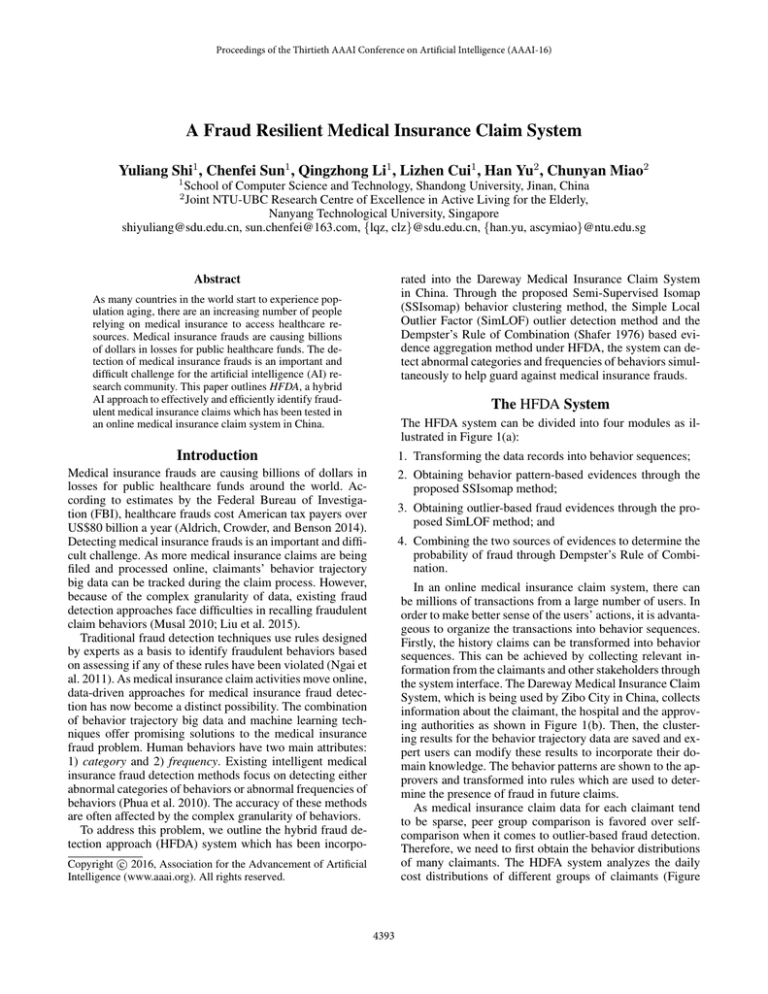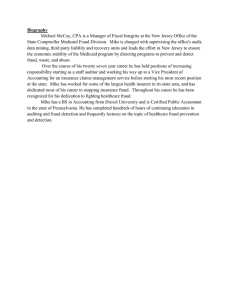
Proceedings of the Thirtieth AAAI Conference on Artificial Intelligence (AAAI-16)
A Fraud Resilient Medical Insurance Claim System
Yuliang Shi1 , Chenfei Sun1 , Qingzhong Li1 , Lizhen Cui1 , Han Yu2 , Chunyan Miao2
1
School of Computer Science and Technology, Shandong University, Jinan, China
Joint NTU-UBC Research Centre of Excellence in Active Living for the Elderly,
Nanyang Technological University, Singapore
shiyuliang@sdu.edu.cn, sun.chenfei@163.com, {lqz, clz}@sdu.edu.cn, {han.yu, ascymiao}@ntu.edu.sg
2
rated into the Dareway Medical Insurance Claim System
in China. Through the proposed Semi-Supervised Isomap
(SSIsomap) behavior clustering method, the Simple Local
Outlier Factor (SimLOF) outlier detection method and the
Dempster’s Rule of Combination (Shafer 1976) based evidence aggregation method under HFDA, the system can detect abnormal categories and frequencies of behaviors simultaneously to help guard against medical insurance frauds.
Abstract
As many countries in the world start to experience population aging, there are an increasing number of people
relying on medical insurance to access healthcare resources. Medical insurance frauds are causing billions
of dollars in losses for public healthcare funds. The detection of medical insurance frauds is an important and
difficult challenge for the artificial intelligence (AI) research community. This paper outlines HFDA, a hybrid
AI approach to effectively and efficiently identify fraudulent medical insurance claims which has been tested in
an online medical insurance claim system in China.
The HFDA System
The HFDA system can be divided into four modules as illustrated in Figure 1(a):
Introduction
1. Transforming the data records into behavior sequences;
Medical insurance frauds are causing billions of dollars in
losses for public healthcare funds around the world. According to estimates by the Federal Bureau of Investigation (FBI), healthcare frauds cost American tax payers over
US$80 billion a year (Aldrich, Crowder, and Benson 2014).
Detecting medical insurance frauds is an important and difficult challenge. As more medical insurance claims are being
filed and processed online, claimants’ behavior trajectory
big data can be tracked during the claim process. However,
because of the complex granularity of data, existing fraud
detection approaches face difficulties in recalling fraudulent
claim behaviors (Musal 2010; Liu et al. 2015).
Traditional fraud detection techniques use rules designed
by experts as a basis to identify fraudulent behaviors based
on assessing if any of these rules have been violated (Ngai et
al. 2011). As medical insurance claim activities move online,
data-driven approaches for medical insurance fraud detection has now become a distinct possibility. The combination
of behavior trajectory big data and machine learning techniques offer promising solutions to the medical insurance
fraud problem. Human behaviors have two main attributes:
1) category and 2) frequency. Existing intelligent medical
insurance fraud detection methods focus on detecting either
abnormal categories of behaviors or abnormal frequencies of
behaviors (Phua et al. 2010). The accuracy of these methods
are often affected by the complex granularity of behaviors.
To address this problem, we outline the hybrid fraud detection approach (HFDA) system which has been incorpo-
2. Obtaining behavior pattern-based evidences through the
proposed SSIsomap method;
3. Obtaining outlier-based fraud evidences through the proposed SimLOF method; and
4. Combining the two sources of evidences to determine the
probability of fraud through Dempster’s Rule of Combination.
In an online medical insurance claim system, there can
be millions of transactions from a large number of users. In
order to make better sense of the users’ actions, it is advantageous to organize the transactions into behavior sequences.
Firstly, the history claims can be transformed into behavior
sequences. This can be achieved by collecting relevant information from the claimants and other stakeholders through
the system interface. The Dareway Medical Insurance Claim
System, which is being used by Zibo City in China, collects
information about the claimant, the hospital and the approving authorities as shown in Figure 1(b). Then, the clustering results for the behavior trajectory data are saved and expert users can modify these results to incorporate their domain knowledge. The behavior patterns are shown to the approvers and transformed into rules which are used to determine the presence of fraud in future claims.
As medical insurance claim data for each claimant tend
to be sparse, peer group comparison is favored over selfcomparison when it comes to outlier-based fraud detection.
Therefore, we need to first obtain the behavior distributions
of many claimants. The HDFA system analyzes the daily
cost distributions of different groups of claimants (Figure
c 2016, Association for the Advancement of Artificial
Copyright Intelligence (www.aaai.org). All rights reserved.
4393
daily cost of different diseases
Medical Insurance
Claim Behaviors
SSIsomap
0.025
SimLOF
Outlier-based Evidence
0.005
Domain
Knowledge
Behaviour Patterns
0.010
Behaviour Classes
0.015
Recode
Clinical
Processes &
Pharmacopia
Density
Behaviour Sequences
pneumonia
RTI
gastroenteritis
CPN
0.020
Transform
0.000
Dempster’s Rule of Combination
Probability of
Fraud
0
100
200
300
400
500
600
700
cost(yuan)
(a) The HFDA system.
(b) The medical insurance claim submission user interface of the Dareway
Medical Insurance Claim System.
(c) Daily cost distributions of different
groups of claimants.
Figure 1: The system architecture, interface, and results from HFDA.
by the Interactive and Digital Media Programme Office; and
the Lee Kuan Yew Post-Doctoral Fellowship Grant.
1(c)) to build up a baseline to identify outliers. For new
claims, the proposed SimLOF method looks for groups of
related applicants and check if the new expenditure is within
the baseline distribution.
With the obtained pattern-based evidence and the outlierbased evidence, the HFDA system calculates the probability
of fraud for new claims using Dempster’s Rule of Combination (Shafer 1976). Claim approvers can check the status of
new claims through the HDFA system. Records highlighted
in red indicate high probabilities of fraud.
References
Aldrich, N.; Crowder, J.; and Benson, B. 2014. How much does
medicare lose due to fraud and improper payments each year? The
Sentinel.
Cai, Y.; Shen, Z.; Liu, S.; Yu, H.; Han, X.; Ji, J.; McKeown, M. J.;
Leung, C.; and Miao, C. 2014. An agent-based game for the predictive diagnosis of parkinson’s disease. In AAMAS’14, 1663–1664.
Liu, J.; Bier, E.; Wilson, A.; Honda, T.; Kumar, S.; Gilpin, L.;
Guerra-Gomez, J.; and Davies, D. 2015. Graph analysis for detecting fraud, waste, and abuse in healthcare data. In IAAI-15, 3912–
3919.
Musal, R. M. 2010. Two models to investigate medicare fraud
within unsupervised databases. Expert Systems with Applications:
An International Journal 37(12):8628–8633.
Ngai, E.; Hu, Y.; Wong, Y. H.; Chen, Y.-J.; and Sun, X. 2011. The
application of data mining techniques in financial fraud detection:
A classification framework and an academic review of literature.
Decision Support Systems 50(3):559–569.
Phua, C.; Lee, V.; Smith, K.; and Gayler, R. 2010. A comprehensive survey of data mining-based fraud detection research. arXiv
1–14.
Shafer, G. 1976. A Mathematical Theory of Evidence. Princeton
University Press.
Yu, H.; Cai, Y.; Shen, Z.; Tao, X.; and Miao, C. 2010. Agents as
intelligent user interfaces for the net generation. In IUI’10, 429–
430.
Yu, H.; Shen, Z.; Miao, C.; and Tan, A.-H. 2011. A simple curious
agent to help people be curious. In AAMAS’11, 1159–1160.
Yu, H.; Miao, C.; An, B.; Leung, C.; and Lesser, V. R. 2013. A
reputation management approach for resource constrained trustee
agents. In IJCAI’13.
Yu, H.; Miao, C.; An, B.; Shen, Z.; and Leung, C. 2014a.
Reputation-aware task allocation for human trustees. In AAMAS’14, 357–364.
Yu, H.; Yu, X.; Lim, S. F.; Lin, J.; Shen, Z.; and Miao, C. 2014b.
A multi-agent game for studying human decision-making. In AAMAS’14, 1661–1662.
Discussions and Future Work
HFDA serves as a useful tool for medical insurance claim
approvers to leverage people’s behavior trajectory data to
combat frauds. In future research, we will design decision
support mechanisms to recommend suitable actions against
potential medical insurance frauds for claim approvers. Human factors concepts such as emotion (Yu et al. 2010), curiosity (Yu et al. 2011), reputation (Yu et al. 2013), wellbeing considerations (Yu et al. 2014a) and decision-making
characteristics (Yu et al. 2014b) will be explored to help the
HFDA interface agent build trust with the users. The behaviour trajectory data in wellness games (Cai et al. 2014)
will also be incorporated into HFDA for analysis.
Acknowledgements
This research is supported, in part, by the National
Natural Science Foundation of China under Grant No.
61572295, 61573212, 61272241; the Natural Science
Foundation of Shandong Province of China under Grant
No. ZR2014FM031, ZR2013FQ014; the Shandong
Province Independent Innovation Major Special Project
No. 2015ZDXX0201B03; the Shandong Province key
research and development plan No. 2015GGX101015,
2015GGX101007; the Fundamental Research Funds of
Shandong University No. 2015JC031; the National Research Foundation, Prime Minister’s Office, Singapore
under its IDM Futures Funding Initiative and administered
4394



